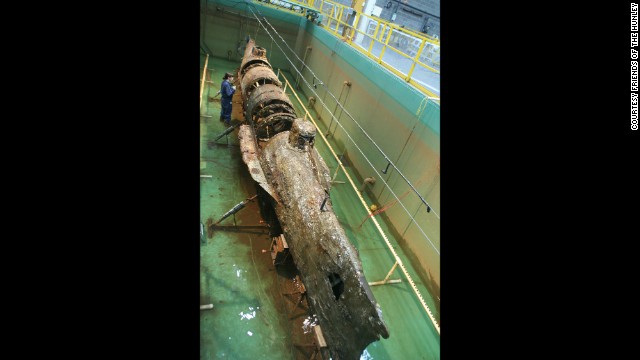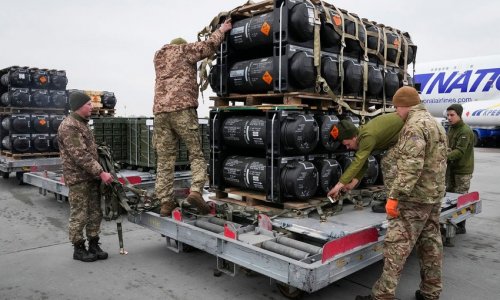The 150th anniversary of the Hunley's daring and dangerous raid will be marked this weekend and Monday, but the overarching question remains: What caused the submarine and its eight-member crew to slip to the bottom of the sea on the moonlit evening of February 17, 1864, after it signaled to shore a success that changed naval warfare.The Hunley, housed at a laboratory in North Charleston, South Carolina, has yielded its secrets slowly and sparingly, even to researchers armed with the latest in technology.Was the loss of the Hunley the result of the torpedo's detonation? An unsecured hatch? Or perhaps a lucky enemy shot that blasted a hole in the Confederate vessel's viewing port?And why were the crew's remarkably preserved remains found at their stations, rather than jammed together near an escape hatch?These and other questions continue to enthrall scientists and historians as the sesquicentennial is observed with tours and events in the Charleston area.Unmasking the Hunley's secrets 2013: New evidence in Hunley sinkingThere is hope that some additional clues may emerge soon.The Hunley Project, a consortium of researchers, scientists and state and federal agencies, this year begins a conservation phase that might add an important piece to the puzzle of what happened to the submarine. A chemical bath will peel away the final layer of sediment that covers the exterior of the well-constructed hull and the Hunley's interior.What we know about the doomed crew"You are going to be blown away. You are going to look at the face of the submarine for the first time," says Paul Mardikian, the project's senior conservator.Already, the Hunley impresses visitors who gaze down to a 90,000-gallon freshwater conservation tank. Dive planes and remnants of other submarine components, including ballast tanks, are evidence of the innovation and care of the sub's designers and builders.Patrons at the Warren Lasch Conservation Center also see the encrusted sediment, known as concretion -- a mix of sand and remains of sea life -- that Mardikian likens to a "black box."By removing the material, he says, researchers will be able to do more precise analysis of holes in the hull and its condition, the Hunley's speed and performance in the Atlantic Ocean and whether gunfire from the USS Housatonic, its target, contributed to the submarine's demise."If the submarine was hit by a bullet, you should be able to see that in the metal," says the conservator.By combining new findings with previous study, including that of the remains of the crew, experts believe they will be able to tell the complete story of what happened to the Hunley, which was brought to the surface amid much fanfare in August 2000."I am confident this is all going to fall into place," says Mardikian.But don't be surprised if everything falling into place won't result in a "smoking gun" that points to a single cause."There may be several things (factors) happening at the same time," according to Mardikian.Archaeologist Michael Scafuri says the team is trying to ascertain the truth of what happened that chilly night a few miles offshore from Charleston. But there are no guarantees."It is like detective work -- with a really cold case."'Curious' submarine a danger to its crews, tooThe cold case begins in Mobile, Alabama, where the Hunley was built for the Confederate government.The 40-foot vessel, described as "curious" looking and resembling a whale, had watertight hatches, two short conning towers, sea cocks, pumps and ballast tanks.But there were shortcomings. There was constant concern about a sufficient oxygen supply for the crew, which limited its dive time. The captain had a difficult time monitoring certain movements.The Hunley was dependent on the crew hand-turning a crank to power the single propeller. Batteries and a steam-powered engine proved impractical for the submersible."We don't know how real well the submarine functioned," says Scafuri. "This is a case where they settled on what would work. That was hand power."Confederate officials ordered the Hunley to Charleston, where it and other ships prepared to challenge a blockade of the harbor. The Federal Navy had deprived the Southern city of vital military supplies.The Union fleet was well aware of the Hunley's danger -- to its own occupants.Five members of the first crew died in August 1863 when it accidentally dived while its hatches apparently were open. The second crew's eight members succumbed in October when the Hunley failed to return to the surface.The Confederate commander of Charleston, concerned about the loss of life and the expense of recovering the Hunley, ordered that any attack be made on the surface. Still, the vessel would be mostly under the water line during an attack.Still, those who volunteered for the mission against the 205-foot USS Housatonic must have been well aware of the perils when approached by Hunley skipper Lt. George Dixon."This took some serious bravery here. I wouldn't want to go in there," says forensic genealogist Linda Abrams, who has conducted extensive research on the Hunley crew. "They know some other people had drowned in it. They had to have some faith in Dixon."Dixon and his courageous crew, which included four European-born men, would target the Housatonic, the closest blockade ship.Dixon routinely kept a worn good-luck charm in his pocket: A gold coin that was bent when he was wounded nearly two years before at the Battle of Shiloh in Tennessee.In 2001, the shiny talisman was found in the laboratory, along with Dixon's presumed remains. Only one crew member has been positively identified through DNA tests.Menacing object approaches wary shipOn a chilly February evening 150 years ago, the Hunley set out from Breach Inlet, which separates Sullivan's Island and what is now called the Isle of Palms. The vessel churned toward the Housatonic, about 4 miles away, at an estimated speed of 2 to 4 knots.One of the crew members would have been in charge of bellows, providing sufficient air to breathe when the hatches were closed.Friends of the Hunley, a nonprofit group established by South Carolina's Hunley Commission, provides a history of the mission on its website."While the cold bit through the lookout's coat ... men poured sweat over hand cranks that powered a spinning propeller while their captain manned the dive planes -- steering man, iron, anxiety and raw courage towards its final destination.""A lookout aboard the Union Navy's largest ship was tired, cold -- but restless. Talk of a Confederate secret weapon was in and out of his thoughts. Suddenly he spotted something move in the chilly waters. A porpoise? There were certainly a lot of them around. But something about this one didn't seem right."Alarms went out on the Housatonic, which carried 12 guns.The Hunley was too close and low to be hit by artillery fire, so crew and officers of the Union ship fired small arms, rifles and even a shotgun at the approaching menace.Once in place, a submarine crew member managed to pull the lanyard for the 135-pound torpedo, attached to a 16-foot spar that was still connected to the Hunley's bow.The Housatonic sank within minutes.Five members of the Union vessel died; 150 others were rescued.All kinds of scenarios for loss of HunleyA Union sailor who climbed to the Housatonic's rigging and a Confederate observer on the shore reported seeing a blue light emanating from the Hunley, signaling mission accomplished."That indicates someone was conscious after the sinking of the Housatonic," says Robert Neyland, head of underwater archaeology for the Naval History and Heritage Command and former director of the Hunley Project.But researchers have been unable to precisely pinpoint the source of the light -- whether it came from a lantern or pyrotechnic device that sent out various signal colors. And it's possible the light came from Union rescuers.Experts looked at the Hunley's lantern, but found no evidence of blue glass."I think it was just Dixon's flashlight, to be honest," says Mardikian, the conservator.One scenario holds that the Hunley was swamped by or struck by a Union vessel. Or that it plunged to the sea floor to avoid detection, and never made it back up. A latch on the forward conning tower was found to be not properly locked.In January 2013, Hunley scientists, who work for the Clemson University Restoration Institute, reported a significant discovery."Until now, the conventional wisdom has been the Hunley would ram the spar torpedo into her target and then back away, causing the torpedo to slip off the spar," they said in a statement.Instead, research showed the submarine was less than 20 feet from her torpedo when it exploded."There is overwhelming evidence to indicate this was not a suicide mission. The crew no doubt knew the dangers facing them, but still, they hoped to make it back home. They must have believed this was a safe enough distance to escape any harm," says South Carolina Lt. Gov. Glenn McConnell, head of the Hunley Commission.It's possible that the force of the explosion incapacitated the crew, eventually causing the sub to slide down into the chilly depths. Even a small hole or holes could have allowed water to seep or pour in."Everything we have tried to explain (as to) how the submarine worked, we were naïve in our approach," says Mardikian.Researchers at the lab, while excavating the sub's interior silt that held the the human remains, found the eight Hunley crew members were still at or near their stations, despite an unsealed forward hatch."We don't see evidence of anyone trying to get out of the submarine. It could have been something catastrophic or they died with a certain amount of resignation," Neyland says.Detailed examinations of the well-preserved remains of the crew looked for the tiniest of fractures or evidence of concussion. "We did not find any unhealed injuries to their skeletons," says Scafuri, the Hunley Project archeologist.The team is still gathering and analyzing data on the physics and effects of the detonation on the Hunley and its doomed crew, he says. It also continues to analyze the source of holes in the hull, possibly from battle damage or exposure to currents and underwater conditions.Ongoing efforts to learn more about sub, crewIn 1995, the Hunley was finally located by a group led by author Clive Cussler. It rested in several feet of silt, largely protected from strong currents and the most corrosive effects of saltwater. The environment, mostly free of oxygen, left the skeletal remains and artifacts in amazing condition.The submarine was brought to the surface five years later and was quickly placed back in protective water at the Lasch laboratory.The federal and South Carolina governments have contributed an estimated $9 million or so between them on the recovery, lab and research. The Hunley, considered a spoil of war, is the property of the U.S. Navy.About 40,000 visitors a year marvel at the Hunley, see exhibits and peer at facial reconstructions of the crew members.Researchers found personal artifacts, including a wallet, watch, bandana, matchsticks and remains of tobacco pipes.One mystery was answered relatively early in the excavation and conservation process."They didn't know whether these guys had escaped and tried to swim to shore," genealogist Abrams says of the Hunley crew. "Or whether they had been taken captive. There was no concrete knowledge that they were still inside."Inside the sub, scientists found human hair, complete skeletons and skulls of eight people -- debunking one part of the legend that held that nine men were on board.Abrams has spent years trying to learn more about the crew. She has learned a great deal, but is hampered by the fact that only one is known to have married and have children. And there are no known photographs of any.Kellen Correia, executive director of Friends of the Hunley, says she expects a permanent museum to be built around the end of the decade, with expanded days of operation, instead of the current weekends.For the anniversary of the attack, the first 150 visitors on Saturday and Sunday receive free replicas of Lt. Dixon's gold coin, which is on permanent display. Admission on Monday, the actual anniversary, is $1.50, compared to the normal $12 ticket.Abrams, the genealogist, was to share her latest research on the crew at a $50 Saturday evening reception.At 7 p.m. Monday -- timed to the hour the Hunley was making its way toward the Housatonic -- a memorial service will be held at Sunrise Presbyterian Church near Breach Inlet for those killed on both warships. Participants will then drop flowers into the water in remembrance.Correia is accustomed to debates over the Hunley's demise."I love that it engages people," she says. "You know why the Titanic went down. With this, you don't have that known factor."Piece of Civil War ironclad brought to surfaceWhat caused the HMS Bounty to go down?Booty from Blackbeard's sunken ship: Five huge cannonsGhostly underwater art gallery breathes new life to sunken ship(CNN)ANN.Az
Zeroing in on what caused Civil War submarine's sinking - PHOTO
World
09:15 | 18.02.2014

Zeroing in on what caused Civil War submarine's sinking - PHOTO
Born and built amid gray-cloaked secrecy during the American Civil War, the H.L. Hunley -- the first submarine to sink an enemy ship -- has held tight to its murky mysteries.
Follow us !










